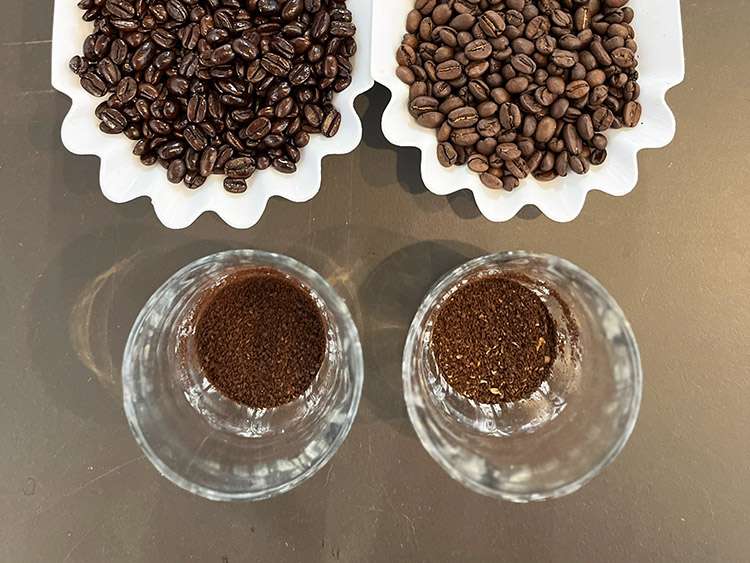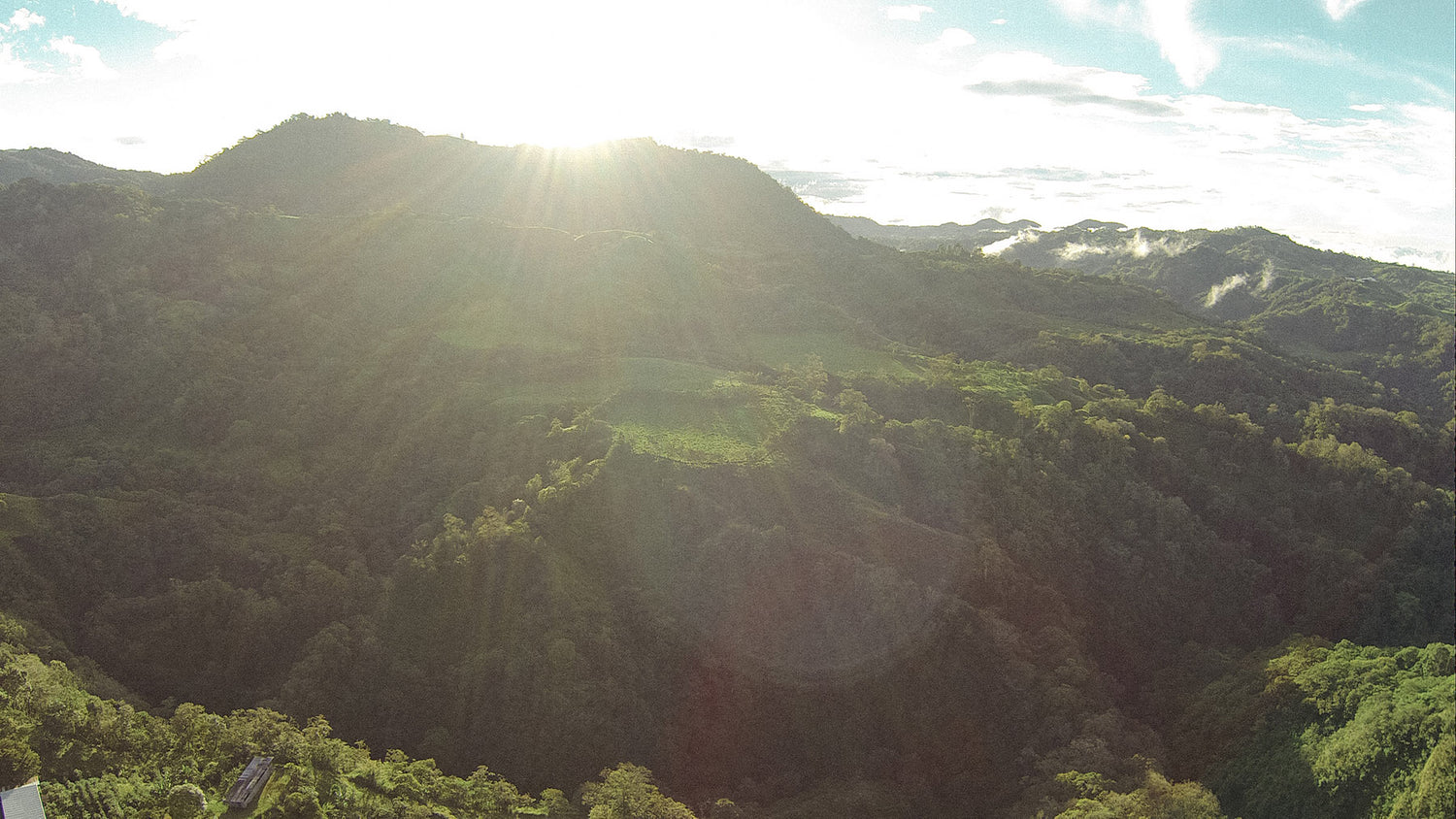Oily coffee beans - yes or no? Well, maybe you've already looked in your coffee packet and discovered a pile of very oily coffee beans instead of the usual dry coffee beans. Or maybe you had oil in the coffee bag! In principle, that's not a bad thing, but it's also not a sign of something good. The whole thing is very differentiated and subjective. We'll explain the whole thing to you objectively and then you can make your own judgment about it.
Oily coffee beans – where does it come from?
Coffee beans are basically seeds. The seeds of the coffee plant. And like all seeds , coffee beans contain lots of amino acids, carbohydrates and fats. And under certain circumstances, these also come out of the seeds. One reason for oil coming out of the beans is roasting. The more heat the coffee beans are exposed to, the more likely you are to get oily coffee beans. The lipids, i.e. fats, come out through the long roasting process and form an oily film on the bean. This can mean that oily, especially dark roasted coffee beans, are very fresh.
Oily coffee beans – dark roast
The phenomenon of oily, dark beans occurs primarily with very dark roasts such as French or Italian roasts. However, you should also expect special flavor nuances here: very dark roasts have dominant roasted aromas, they can even taste very smoky and like charcoal. Some people like that, others don't. But one thing is certain: with very dark roasts, oily beans are more of a sign that the roast is very fresh. Unlike with light or medium roasts.

Oily coffee beans – light and medium roasts
If you have a medium or even a light roast in your hand and the beans are oily, then you should probably stay away from it. Here the oils have migrated from the inside to the outside over a long period of time. Normally light or medium roasted beans are dry and dull in appearance. This suggests that the coffee is very old and has been stored poorly or even incorrectly. In terms of taste, this coffee will definitely be stale and bland . So don't drink it.
Detecting oily coffee beans
Recognizing oily coffee beans is actually very easy. Open the packet and look inside. If the beans are oily, you'll see it. You can also take a sniff and maybe you'll be able to smell it: As already mentioned, dark and oily roasts have a smoke and charcoal aroma. You can smell that straight away. But you could also smell it with light and medium roasts that are oily. Since they were certainly stored for far too long, it could be that the oil that has leaked out has already gone a bit rancid and therefore smells that way.
Oily coffee beans – history
Historically, very dark roasts came into fashion when the demand for coffee increased significantly. Not all green coffee on the market was of good quality and it seemed practical to roast the inferior coffee very dark to mask the inferior or even bad taste. Coffee drinkers would then only taste the smoky flavor of the roast or use the coffee to make espresso, which of course produces strong and oily flavors. There are certain Brazilian and Colombian coffees out there that lend themselves to being roasted very dark. However , most of the time it can be said that very dark roasted coffee beans are used when cheaper green coffee has been purchased .
Many coffee lovers don't like using dark roasts or oily coffee beans because the long roasting process changes the natural flavors of the coffee. You could almost say that you roast away all the flavor by driving the coffee oils to the surface of the bean. In addition, some of the coffee oil should remain in the bean because that is important for a good crema.

Oily coffee beans – harmful for machines?
Even though they are often used for espressos, dark, oily coffee beans can actually be harmful for automatic espresso machines, fully automatic machines or coffee grinders. The oil can build up in the machine and in the grinder and contribute to the components jamming. These deposits must be removed again and again. If the deposits are not removed, they can cause the machine to stop working completely . It is therefore important to regularly clean the grinders, bean containers and, in the case of fully automatic machines, also the pipes and hoses.
Oily coffee beans – what to do?
An interesting question that divides the coffee world. Some people like oily, dark roasted beans, others don't. So all we can say is that it's more about why the beans are oily and how it came about. If you buy a pack of coffee and the beans are oily and dark roasted, there's a chance that's how it's supposed to be. A look at the roasting or best-before date will tell you. If they're fresh and you like very dark beans, then put them in the machine/grinder. And if you don't like them - maybe give them away? Throwing them away is always such a shame.
If, however, you get a pack of light or medium roasted beans and they are oily, then it is quite possible that they are old and bland. If you buy a pack like this, then you should perhaps talk to the seller and definitely take a look at the roasting or MH date. If you caused this yourself by storing the beans for too long or incorrectly, then unfortunately the only solution is to throw them in the trash.
Oily coffee beans – Arabica and Robusta
The two types of coffee that are relevant for the global market are Arabica and Robusta. Both have different properties, such as different amounts of caffeine or different cultivation altitudes and, as a result, different amounts of coffee oil.
Arabica – less oily coffee beans
Arabica beans are the most common coffee beans on the market and account for around two thirds of global coffee production. They usually grow at higher altitudes of 1,000 metres and above and require a little more care and attention. Arabica beans are generally less oily than Robusta beans and generally have a finer range of flavours, a natural sweetness and a very balanced acidity.
Robusta – oily coffee beans
The Robusta bean accounts for a good third of global coffee production. It is more robust in cultivation against pests, diseases and environmental conditions. It grows more often at lower altitudes below 1,000 meters and has a higher caffeine content than Arabica beans. It also has a higher oil content and impresses with its bitterness and strong, earthy taste. Due to the high oil content, these beans are ideal as an addition to espresso blends, because the oil content ensures a beautiful crema .
Oily coffee beans – which roasts tend to
As mentioned, dark roasts tend to be oilier. But there are differences here too. The following roasting levels are available.
Cinnamon Roast: light brown color with pronounced acidity
New England Roast: complex acidity, moderate light brown
American Roast: medium brown, slightly sweeter, full body with acidic notes
City Roast: a balanced body with noticeable acidity, a medium brown tone
Full City Roast: medium dark brown, roasted aromas
Vienna Roast: intense dark brown, bittersweet, caramel notes
French Roast: dark brown beans, shiny with oil, pronounced roasted aromas, sweet, chocolaty
Italian Roast: intense dark brown, very shiny beans, pronounced roasted aromas, hardly any acidity
And we have also come across almost black coffee beans, very shiny and very oily, with aromas of smoke and charcoal (sometimes called Sicilian roast ).

Oily coffee beans – summary:
You won't find any oily coffee beans in our shop . Firstly, we roast them fresh every day and secondly, our dark roasts are a little lighter than others. Nevertheless, or perhaps precisely because of this, our espresso roasts taste particularly good . Yes, a little self-praise is allowed. And here's the short version of when oily coffee beans are OK and when they aren't.
- Oily & dark: mostly freshly roasted, roasted aromas, sometimes smoke and charcoal, chocolate. Resulting from long and/or very hot roasting. -> OK
- Oily & light/medium: mostly old, bland and tasteless, possibly rancid. Caused by very long and incorrect storage. -> not OK
So be sure to check the roasting or best-before date if you're a fan of oily coffee beans. Otherwise, as always: Whatever you like tastes good and that's a good thing. #staywild


